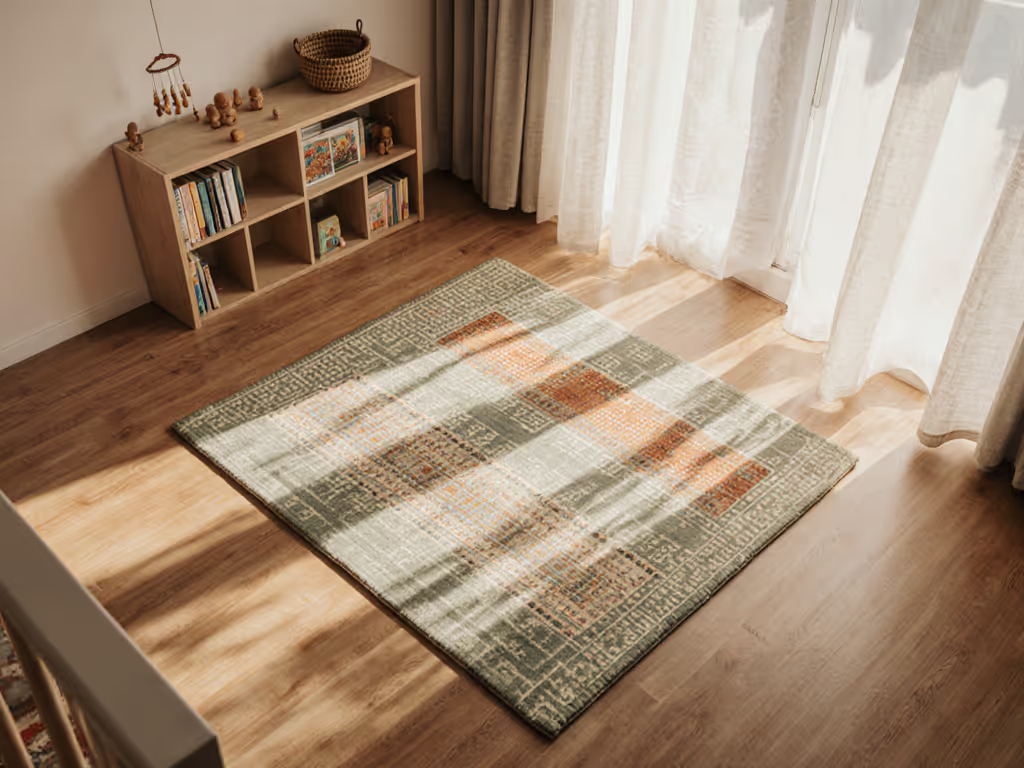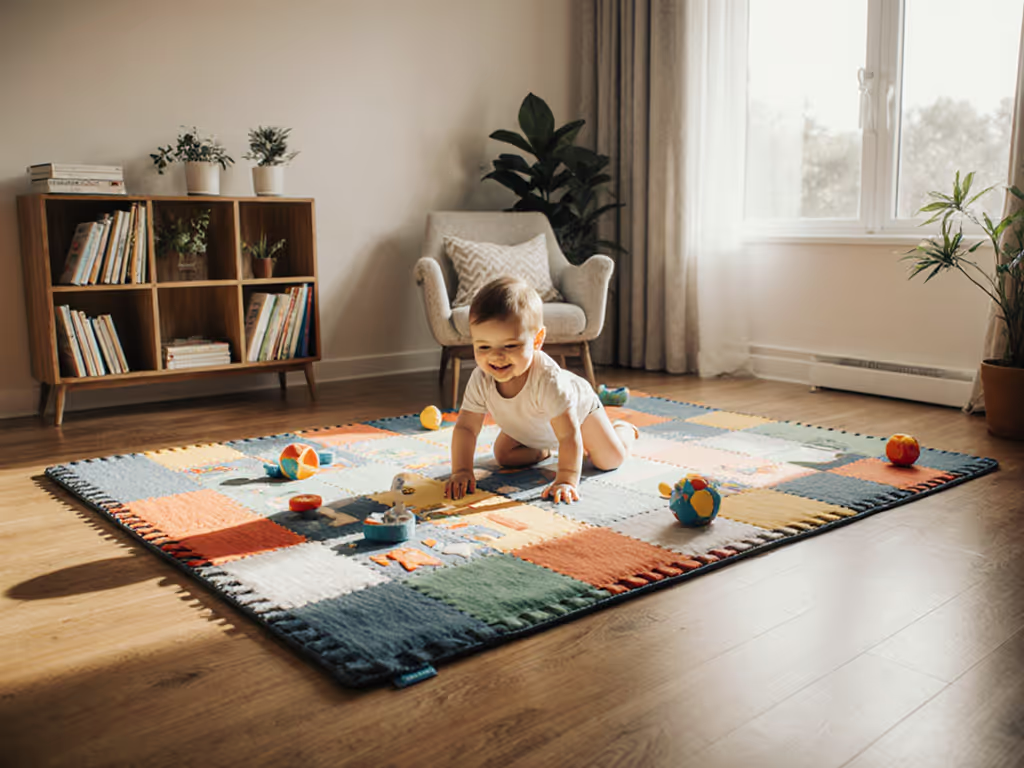
What Is a Play Mat? Complete Guide for Families

Did you know that over 70 percent of parents say a safe play space at home is their top priority for young children? As little ones begin to crawl and explore, unprotected floors can pose real risks to both comfort and safety. Play mats give families peace of mind by turning any room into a secure, welcoming environment that encourages movement, play, and early development without constant worry.
Key Takeaways
| Point | Details |
|---|---|
| Safety Standards are Crucial | Prioritize play mats that meet rigorous international safety certifications to ensure child safety and protection from harmful materials. |
| Developmental Support | Choose play mats that encourage sensory exploration and motor skill development, providing safe spaces for children to learn and grow. |
| Material Matters | Select play mats made from durable, easy-to-clean, and non-toxic materials to ensure long-term use and safe play environments. |
| Personalized Selection | Consider your child's age, developmental stage, and specific needs when choosing a play mat to maximize functionality and comfort. |
Defining Play Mats for Family Use
Play mats are specialized protective surfaces designed to create a safe, comfortable space for infants and young children to explore, play, and develop critical motor skills. Cushioned play surfaces transform ordinary floors into dedicated child-friendly zones, offering parents peace of mind while supporting their child's early developmental journey.
Typically crafted from soft, durable materials like foam, rubber, or padded textiles, play mats provide multiple functions beyond simple floor coverage. They serve as protective boundaries that cushion potential falls, create designated play areas, and offer insulation from cold or hard surfaces. Modern play mats come in various sizes, designs, and thickness levels to accommodate different developmental stages - from newborn tummy time to toddler crawling and early walking adventures.
Key features that distinguish quality play mats include:
- Shock-absorbing materials that minimize injury risks
- Easy-to-clean surfaces for quick maintenance
- Non-toxic construction ensuring child safety
- Interlocking designs allowing customizable space configurations
- Engaging visual patterns that stimulate infant cognitive development
Beyond physical protection, play mats represent more than just a safety accessory. They are developmental tools that create dedicated spaces for children to explore, learn, and grow - transforming ordinary living spaces into interactive learning environments that support crucial early childhood milestones.
Types of Play Mats and Key Differences
Play mats are not a one-size-fits-all solution, with diverse materials and designs tailored to different family needs and child developmental stages. Foam play mats represent the most common and versatile option, offering soft, lightweight protection that can be easily configured and moved around living spaces.
Material variations significantly impact a play mat's performance and suitability. EVA foam mats provide excellent shock absorption and are typically non-toxic, making them ideal for infants. PVC-free options cater to environmentally conscious families, while polyester fiber mats offer enhanced durability and easier cleaning. Some specialized mats incorporate eco-friendly materials like degradable polypropylene, appealing to parents seeking sustainable childcare solutions.
Key play mat categories include:
Here's a comparison of common play mat types and their key characteristics:
| Play Mat Type | Material | Key Benefits | Ideal For |
|---|---|---|---|
| Foam Tile Mat | EVA Foam | Customizable<br>Shock absorbent | Infants<br>Toddlers |
| Rubber Flooring | Rubber | Durable<br>Non-slip | Active play<br>High-traffic areas |
| Carpet Tile Mat | Textile | Soft texture<br>Warm | Comfort-focused play zones |
| Artificial Grass Mat | Polypropylene | Indoor/outdoor use<br>Eco options | Varied environments |
| PVC Interlocking Tile | PVC | Robust<br>Easy to clean | Older toddlers<br>Durability needs |
- Foam Tile Mats: Interlocking designs allowing customizable coverage
- Rubber Flooring: High-durability options for active play zones
- Carpet Tile Mats: Soft textured surfaces providing additional comfort
- Artificial Grass Mats: Indoor/outdoor versatility for varied play environments
- PVC Interlocking Tiles: Robust surfaces ideal for high-traffic play areas
The right play mat depends on specific family requirements - considering factors like available space, child's age, play intensity, and maintenance preferences. Understanding these nuanced differences helps parents select a play mat that genuinely supports their child's safe, engaging play experience.

Essential Features and Safety Standards
When selecting a play mat for children, safety standards are not just recommended - they are crucial. Parents must prioritize play mats that meet rigorous international safety certifications such as CPSIA, EN-71, and AS/NZS 8124, which guarantee protection against harmful chemicals and potential health risks.
Material composition plays a pivotal role in play mat safety. High-quality play mats should be free from dangerous substances like phthalates and formamide, with certifications such as OEKO-TEX Class 1 providing additional reassurance. The best play mats incorporate non-toxic materials that can withstand frequent cleaning and resist bacterial growth, ensuring a hygienic environment for children's play and exploration.
Key safety features to look for include:
- Thick, shock-absorbing surfaces that minimize impact injuries
- Non-slip backing to prevent mat movement during active play
- Seamless or tightly interlocked designs preventing choking hazards
- Smooth, wipeable surfaces for easy sanitization
- Rounded edges to reduce potential injury risks
Beyond physical safety, modern play mats also integrate developmental considerations. Look for designs that offer sensory stimulation, support motor skill development, and provide comfortable spaces for infants and toddlers to learn and play safely. The right play mat is an investment in both child safety and developmental support.
Benefits for Child Development and Play
Play mats are far more than simple floor coverings - they are developmental playgrounds that create structured yet imaginative spaces for children to explore, learn, and grow. These specialized surfaces transform ordinary living areas into interactive environments that actively support cognitive, physical, and sensory development during critical early childhood stages.
Sensory exploration becomes a rich, engaging experience through strategically designed play mats. Vibrant colors, diverse textures, and interactive elements stimulate neural pathways, encouraging infants and toddlers to investigate their surroundings. By providing a safe, cushioned space with visual and tactile stimuli, play mats help children develop spatial awareness, hand-eye coordination, and fundamental motor skills through natural, unstructured play.
Key developmental benefits include:
- Encourages independent movement and exploration
- Supports muscle strength and gross motor skill development
- Provides a safe environment for tummy time and crawling practice
- Stimulates cognitive growth through sensory engagement
- Fosters creativity and imaginative play scenarios
Beyond physical development, play mats create psychological comfort zones where children feel secure enough to take developmental risks. They represent more than just a protective surface - they are foundational learning environments that nurture curiosity, build confidence, and support the remarkable journey of early childhood growth.
Cost, Durability, and Cleaning Considerations
Choosing a play mat involves carefully balancing financial investment with long-term functionality. While initial costs can range from affordable foam tiles to premium designer options, smart families focus on value - seeking durable materials that withstand frequent use, easy cleaning, and potential reuse across multiple children.
Maintenance considerations play a critical role in play mat selection. Low-VOC materials that minimize off-gassing odors and feature smooth, wipeable surfaces provide significant practical advantages. Parents should prioritize play mats that can be quickly sanitized, resist staining, and maintain structural integrity through repeated cleaning cycles. Foldable designs offer additional flexibility, addressing potential storage challenges while providing convenient transportation options.
Key cost and durability factors include:
- Material quality and expected lifespan
- Ease of cleaning and sanitization
- Resistance to wear, tear, and permanent staining
- Versatility across different play environments
- Potential for modular expansion or reconfiguration
Ultimately, the most cost-effective play mat balances upfront pricing with long-term performance. Investing in a high-quality mat that grows with your child - supporting developmental stages while maintaining structural integrity - represents a smart approach to both child safety and household budgeting.
Selecting the Right Play Mat for Your Needs
Selecting the perfect play mat requires careful consideration of multiple technical specifications that extend beyond simple aesthetic preferences. Parents must evaluate critical factors such as material safety, dimensional appropriateness, weight capacity, and compliance with rigorous safety standards like EN71 and ASTM F963 to ensure optimal child protection and developmental support.
Age-specific requirements dramatically influence play mat selection. Newborns need softer, more cushioned surfaces with minimal texture, while active toddlers require more robust mats that can withstand vigorous movement and potential spills. Consider your child's current developmental stage, anticipated growth, and specific play behaviors when making your selection.
Key selection criteria include:
- Precise measurements matching your available space
- Material composition suitable for your child's age
- Surface texture supporting sensory development
- Weight capacity and durability
- Ease of cleaning and maintenance
- Compatibility with your home's design aesthetic
Ultimately, the ideal play mat is a personalized solution that balances safety, functionality, and your family's unique lifestyle.
Don't just purchase a play mat - invest in a developmental tool that grows and adapts alongside your child's remarkable journey of exploration and learning.
Find the Perfect Play Mat That Grows with Your Family
Choosing a play mat that truly fits your home and keeps your child safe during those crucial early years can feel overwhelming. This guide highlights common challenges such as balancing safety standards like EN-71 and ASTM F963 with durability, easy cleaning, and developmental benefits. Many parents worry about selecting materials free from harmful chemicals while also needing a soft, cushioned surface to protect against falls and support motor skill growth.
At FloorBloom, we understand these concerns and offer thoughtfully tested, beautiful play mats designed to meet your family's unique needs. Our collections combine non-toxic materials, customizable sizes, and sensory-friendly textures that encourage safe exploration from newborn tummy time to toddler cartwheels. Don't wait to create a secure and engaging play space for your child. Visit our main store to explore durable options that satisfy both safety and developmental goals — because your child deserves a space that supports every step of their journey.
Take the first step towards peace of mind and lasting quality today by discovering play mats that prioritize safety and growth at FloorBloom Play Mats. Your child's future adventure starts with the right foundation.
Frequently Asked Questions
What is a play mat used for?
Play mats create a safe, cushioned space for infants and young children to play and explore, supporting their motor skill development and providing protection from hard surfaces and potential falls.
Are all play mats made from the same materials?
No, play mats come in various materials, including foam, rubber, and textiles. Foam mats are the most common, while rubber and polyester fiber mats offer different benefits in terms of durability, grip, and cleaning ease.
How do I ensure the play mat I choose is safe for my child?
Look for play mats that meet international safety standards like CPSIA and EN-71, use non-toxic materials free from harmful substances, and have features like shock absorption and non-slip backing to enhance safety during play.
What are the key features to consider when selecting a play mat?
When choosing a play mat, consider its size, material composition, thickness, ease of cleaning, safety certifications, and whether it offers sensory features that can support your child's developmental needs.
Related Articles


What Is a Foldable Play Mat? Complete Guide

Role of Play Mats: Complete Guide for Safe Play Spaces

Play Mat Safety Standards Explained: Essential Guide

